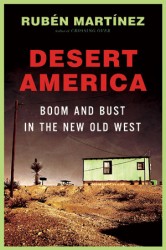|
Author of The Last Prince of the Mexican Empire, etc. |
|
|
|
A memoir of living and traveling through both iconic and off-the-path places from Joshua Tree to Sedona, the Arizona borderlands to the heroin-infested farming communities of New Mexico and, briefly, the artist colony of Marfa, Texas, Desert America is also the story of a son and grandson of Salvadoran and Mexican immigrants trying on and struggling with various identities —guitar-toting “brown cowboy”; Roque Dalton-quoting poet-activist; addict, farmer, husband, father. But more: Desert America is a work of literary journalism in the finest tradition, a novelesque interweaving of vivid and telling detail with interviews and original research. In the chapter “Water in the Desert,” Martínez profiles Mike Wilson, a member of the Tohono O’odham reservation, who makes a spiritual practice of leaving gallon jugs of water in the Baboquivari Valley, a deathtrap of thirst for uncounted hundreds of migrants. Not far from Wilson’s house are tract houses for a different kind of migrant — many of whom take a dim view of Wilson’s endeavor. Wilson named his various depots after the Gospels. After an exhausting day of following him around, writes Martínez: “John Station is in the sun-dappled shade of a mesquite thicket, and with all the splashing from the ten-gallons containers and the hoses, soon there are diamonds of light glinting on every surface, drops of water whose brilliance disappears within seconds as the blazing air sucks the moisture away.” Later, Martínez joins Wilson and a party of Guatemalans in a search for the body of a teenager named Sergio, whose cousin Lucas, residing in San Diego, learned had died two days into his journey from the border. In the car on the way to where they will start the search, Martínez learns that Sergio was 19. He was overweight; he carried a fake Mexican birth certificate. In Guatemala he’d driven a bus and gone into debt for the privilege. A husband and father already, he’d come north for fast cash. His body, Lucas had been told, “was left at the foot of a tree in a wash next to the highway to Arizona City, near a cemetery.” But after a brutal day of searching micro patches of immensity, Wilson, who knew the desert, said, at last, and in good Spanish, “Do you know how many places that could be?” On the flip side of the coin, with “a postcard view of Baboquivari Peak,” on “640 acres of stunning Sonoran desert” is “a handsome house, 1920s vintage with Moroccan arches, tall ceilings and an exquisitely tiled kitchen,” where Martínez interviews its owner, who holds a Ph.D. in anthropology and carries a shotgun. Apart from the menace of rattlesnakes, migrants cross her land. At night, from the house, she can hear the rumbling of the Border Patrol SUVs. “She visualizes them
coming down the saddle between the two hills behind the ranch
house. Walking up to the house, up to the bedroom window, peering
in at her. In “Where the River Bends,” Martínez arrives in Texas’ Big Bend country, to the tiny town of Marfa as a Lannan Fellow, assigned one of their several beautifully refurbished writers’ residences. He covers the basics of the art colony’s history as well if not better than anyone: the filming of the iconic Elizabeth Taylor-Rock Hudson-James Dean vehicle, “Giant”; the arrival of visionary artist Donald Judd, “mad emperor of the rectangles filled with the soul-stirring vistas of the Chihuhuan Desert,” and then, on Judd’s heels, the jet-in multimillionaires in search of space and creatives displacing the old ranching families. But more than a personal memoir or press release-fed bit of travel section fluff, Martínez delves in, hiking with Jeff Fort, ex-Tyco CEO who bought Judd’s fabled Chinati Hot Springs, among other and vast properties; and, recounted with often painful detail, Martínez attends a party at a sleek mansion surrounded by an ocean of plains and mountain views. And more: he looks into Marfa’s Blackwell School, which was the Mexican school — for Marfa’s public schools were not integrated until 1965. That famous scene in “Giant,” where Rock Hudson gets punched out by the waiter who had refused to serve Mexicans, was, alas, based on an ugly reality. There are myriad ugly realities
in the new West — migrants perishing in the deserts, unsustainable
sprawl, conflicts, poverty, an epidemic of addiction — and
while Martínez explores these, yielding powerful insight
into the changing mosaic of peoples, he also shows us the magnet
that is the West’s breathtaking beauty. And it all makes
a symphony of sense. As Martínez writes in his introduction,
“the only way to tell my story, it seemed, was to tell theirs.” |


